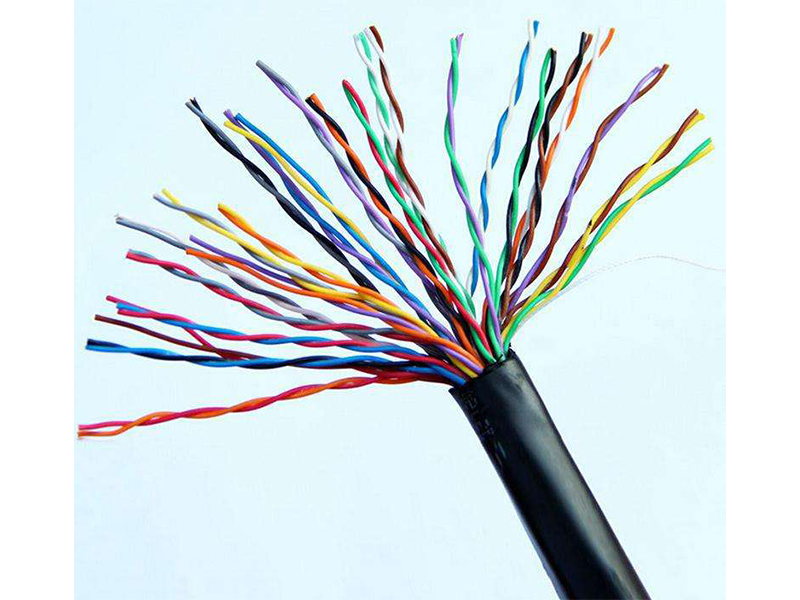Computer cable
Computer cables belong to cables for electrical equipment. The cables are suitable for electronic computers and automatic instruments with high anti-interference requirements under rated voltage of 500V. According to the requirements of different environments and equipment, cable insulation can be made of polyethylene, polyvinyl chloride, cross-linked polyethylene, fluoroplastics, silicone rubber and other materials.
technical parameter
The lowest ambient temperature of conventional computer cable laying is 0 C.
Maximum permissible operating temperature of cable for a long time:
|
Name of insulating material
|
Permissible maximum operating temperature
(℃)
|
|
polyvinyl chloride
|
70
|
|
polyethylene
|
70
|
|
Crosslinked polyethylene
|
90
|
|
Polyolefin Materials
|
90、105、125、150
|
|
silicon rubber
|
180
|
|
Fluoroplastics
|
200
|
Minimum bending radius: The unarmored structure should be no less than 6 times of the cable outer diameter, and the shielded structure with armoured or copper strip should be no less than 12 times of the cable outer diameter.
When charging steadily for 1 minute with DC 500V voltage test at 20 C, the insulation resistance should conform to:
|
Insulating materials
|
Minimum Insulation Resistance
MΩ·km
|
|
Polyethylene, Crosslinked Polyethylene, Fluoroplastics
|
3000
|
|
Polyvinyl chloride, silicone rubber
|
25
|
There should be a continuous path between the twisted shield pairs and between the twisted shield pairs and the total shield pairs.
Cable cores and cores as well as cores and shielding or other metal layers should withstand 50Hz, AC voltage 2000V/1min or 1500V/5min without breakdown.
Polyethylene has high insulation resistance, good voltage resistance, small dielectric coefficient, and little influence on dielectric loss temperature and frequency. It not only meets the requirements of transmission performance, but also ensures the service life of cable.
In order to reduce the mutual interference and external interference between loops, shielding structure should be adopted. Shielding materials include tin-plated or non-tin-plated copper wires, copper strips, copper-plastic composite tapes, aluminum-plastic composite tapes, etc. Metal strips are produced by wrapping, and the lapping rate should usually be no less than 15%, but specific standards have special provisions, such as TICW/06, which stipulates that the lapping rate of shielding metal strips should be no less than 25%; metal wires should be woven by braiding production method, and the braiding coverage rate should not be less than 80%, such as anti-interference. High requirements, coverage can not be less than 90%.
The shielding requirements of cables are adopted according to different occasions: sub-shielding (only for strands, each pair of strands has shielding), total shielding (the cable only has a layer of total shielding after the core is formed), sub-shielding + total shielding (including both the above-mentioned structures). According to the higher requirements of users and use occasions, the total shielding structure can adopt a composite shielding mode, that is, it contains two layers of shielding, which is composed of metal band winding and metal wire braiding.
Note: If the cable has a sub-shielding structure, the shielding pairs should have good insulation performance. The outer side of the sub-shielding should be wrapped with polyester or other non-hygroscopic tapes.
Constituent materials
Computer cables belong to cables for electrical equipment. The structure and composition materials of cables for electrical equipment are the most complex. According to the special requirements of operating temperature and working environment, there are many kinds of composition materials for each structure of computer cables.
|
Permissible maximum operating temperature
(℃)
|
Name of insulating material
|
Sheath Material Name 2
|
|
70
|
Polyethylene, polyvinyl chloride, thermoplastic polyolefin
|
Polyethylene and polyvinyl chloride
|
|
90
|
Polyvinyl chloride, crosslinked polyethylene, thermoplastic or thermosetting polyolefins
|
Polyvinyl chloride, thermoplastic or thermosetting polyolefins
|
|
105
|
Polyvinyl chloride, thermosetting polyolefin material 1
|
Polyvinyl chloride and thermosetting polyolefins
|
|
125、150
|
Thermosetting polyolefin material 1
|
Thermosetting polyolefins
|
|
180
|
silicon rubber
|
silicon rubber
|
|
200
|
Fluoroplastics
|
Fluoroplastics
|
Note 1: Thermosetting polyolefin insulation over 90 C, irradiation is recommended for crosslinking, especially for insulating materials with flame retardant requirements.
Note 2: Except for fluoroplastics and silicone rubber, other sheath materials can be matched for cables with insulation temperature lower than their own without considering the cost.




